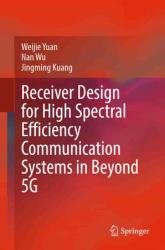 Название: Receiver Design for High Spectral Efficiency Communication Systems in Beyond 5G
Название: Receiver Design for High Spectral Efficiency Communication Systems in Beyond 5GАвтор: Weijie Yuan, Nan Wu, Jingming Kuang
Издательство: Springer
Год: 2023
Страниц: 157
Язык: английский
Формат: pdf (true), epub
Размер: 26.3 MB
This book focuses on the receiver design issue in high spectral efficiency communication systems, which is one of the main research directions in beyond 5G and 6G era. In particular, this book studies two technologies to improve the spectral efficiency, i.e., FTN signaling which transmits more data information in the same time period and NOMA scheme which supports more users with the same resource elements. Different commonly used channel propagation conditions are considered, and advanced signal processing algorithms have been developed for designing receivers, which is suitable for low-complexity receiver design in engineering practice. Moreover, this book discusses possible solutions to further increase spectral efficiency and propose practical receivers in such scenarios. It benefits researchers, engineers, and students in the fields of wireless communications and signal processing.
This research monograph addresses one the most pressing issues of wireless communications, namely the avoidance of the impending ‘spectrum crunch’. In the early era of wireless communications only the police and military as well as the rich and famous have had access to mobile telephony, which resulted in rather limited tele-traffic. Hence having high spectral efficiency was much less critical than in the era at the time of writing, when low-cost commercial devices are readily available to the general public.
The first digital mobile radio system supporting international roaming was the Global System of Mobile communications known as GSM, which was designed and standardized during the late 1980s by the European Union and spread to more than 150 countries across the globe. In this early era it adopted the then extremely radical design principle of using a partial response modulation scheme referred to as Gaussian Minimum Shift Keying (GMSK). The benefit of this partial response scheme is that each modulating symbol’s effect is spread across multiple symbol intervals, which hence facilitates having very smooth, slowly evolving modulated waveforms. When combined with signaling relying on Gaussian shaping of the waveform, it results in the most compact spectral-domain representation that may be attained. This is however achieved at the cost of consciously introducing conrolled intersymbol interference, which necessitates the employment of channel equalization even in the absence of any channel-induced Intersymbol Interference (ISI) or Multiuser Interference (MUI).
By contrast, the Third-Generation (3G) wireless systems opted for the employment of Code Division Multiple Access (CDMA) relying on so-called Orthogonal Variable Spreading Factor (OVSF) codes and a total bandwidth of 5 MHz, which resulted in frequency-selected fading in typical cellular scenarios and hence suffered from the deleterious effects of dispersion that required sophisticated receiver techniques. This realization triggered a spate of research activities on the conception of more bandwidth-efficient non-orthogonal CDMA and a whole host of other non-orthogonal signaling solutions.
This timely research-oriented book follows a similar line of investigation in the emerging 6G era. The rationale is that with the advent of Moore’s Law a whole suite of sophisticated receiver techniques are available for mitigating the deleterious effects of ISI and MUI. Hence the benefits of Faster-than-Nyquist (FTN) signaling are quantified in the presence of radically new receivers. Furthermore, the merits of Sparse Code Multiple Access (SCMA) are discussed, which is also eminently suitable for grant-free access in support of transmitting short messages from IoT nodes for example, with the objective of avoiding the excessive handshaking delays of IoT systems.
Contents:
1. Introduction of High Spectral Efficiency Communication Systems
2. Uplink Multi-user Detection for SCMA System
3. Downlink Multi-user Detection for MIMO-SCMA System
4. FTN Data Detection and Channel Estimation over Frequency Selective Channels
5. Receiver Design for FTN Signaling over Doubly Selective Channels
6. Receiver Design for FTN-SCMA Communication System
7. Receiver Design for FTN-NOMA System with Random Access
8. Current Achievements and The Road Ahead
Скачать Receiver Design for High Spectral Efficiency Communication Systems in Beyond 5G